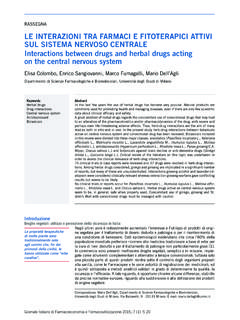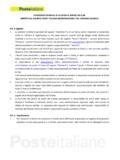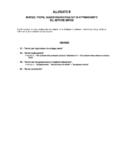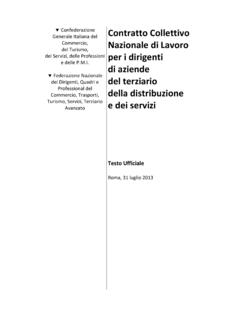Transcription of Haynes RB, Ackloo E, Sahota N, McDonald HP, Yao X
1 Interventions for enhancing medication adherence (Review) Haynes RB, Ackloo E, Sahota N, McDonald HP, Yao XThis is a reprint of a Cochrane review, prepared and maintained by The Cochrane Collaboration and published inThe Cochrane Library2008, Issue 2 for enhancing medication adherence (Review)Copyright 2008 The Cochrane Collaboration. Published by John Wiley & Sons, LtdT A B L E O F C O N T E N T S1 ABSTRACT ..2 PLAIN LANGUAGE SUMMARY ..2 BACKGROUND ..2 OBJECTIVES ..2 CRITERIA FOR CONSIDERING STUDIES FOR THIS REVIEW ..3 SEARCH METHODS FOR IDENTIFICATION OF STUDIES ..3 METHODS OF THE REVIEW ..4 DESCRIPTION OF STUDIES ..4 METHODOLOGICAL QUALITY ..5 RESULTS ..16 DISCUSSION ..19 AUTHORS CONCLUSIONS ..20 POTENTIAL CONFLICT OF INTEREST ..20 ACKNOWLEDGEMENTS ..20 SOURCES OF SUPPORT ..20 REFERENCES ..40 TABLES ..40 Characteristics of included studies ..88 Characteristics of excluded studies.
2 97 Characteristics of ongoing studies ..98 ANALYSES ..98 Comparison 01. Studies that met criteria ..98 INDEX TERMS ..98 COVER SHEET ..99 Analysis Comparison 01 Studies that met criteria, Outcome 01 Adherence and Outcome ..100 GRAPHS AND OTHER TABLES ..iInterventions for enhancing medication adherence (Review)Copyright 2008 The Cochrane Collaboration. Published by John Wiley & Sons, LtdInterventions for enhancing medication adherence (Review) Haynes RB, Ackloo E, Sahota N, McDonald HP, Yao XThis record should be cited as: Haynes RB, Ackloo E, Sahota N, McDonald HP, Yao X. Interventions for enhancing medication Database ofSystematic Reviews2008, Issue 2. Art. No.: CD000011. DOI: version first published online:16 April 2008 in Issue 2, of most recent substantive amendment:15 February 2008A B S T R A C TBackgroundPeople who are prescribed self-administered medications typically take less than half the prescribed doses.
3 Efforts to assist patients withadherence to medications might improve the benefits of prescribed medications, but also might increase their adverse update a review summarizing the results of randomized controlled trials (RCTs) of interventions to help patients follow prescriptionsfor medications for medical problems, including mental disorders but not strategyWe updated searches ofThe Cochrane Library,MEDLINE, CINAHL, EMBASE, International Pharmaceutical Abstracts (IPA),PsycINFO (all via OVID) and Sociological Abstracts (via CSA) in January 2007 with no language restriction. We also reviewed bibli-ographies in articles on patient adherence and articles in our personal collections, and contacted authors of relevant original and criteriaArticles were selected if they reported an unconfounded RCT of an intervention to improve adherence with prescribed medications,measuring both medication adherence and treatment outcome, with at least 80% follow-up of each group studied and, for long-termtreatments, at least six months follow-up for studies with positive initial collection and analysisStudy design features, interventions and controls, and results were extracted by one review author and confirmed by at leastone otherreview author.
4 We extracted adherence rates and their measures of variance for all methods of measuring adherence in each study, and alloutcome rates and their measures of variance for each study group, as well as levels of statistical significance for differences between studygroups, consulting authors and verifying or correcting analyses as needed. The studies differed widely according to medical condition,patient population, intervention, measures of adherence, and clinical outcomes. Therefore, we did not feel that quantitative analysiswas scientifically justified; rather, we conducted a resultsFor short-term treatments, four of ten interventions reported in nine RCTs showed an effect on both adherence and at least one clinicaloutcome, while one intervention reported in one RCT significantly improved patient adherence, but did not enhance the clinicaloutcome. For long-term treatments, 36 of 81 interventions reported in 69 RCTs were associated with improvements in adherence, butonly 25 interventions led to improvement in at least one treatment outcome.
5 Almost all of the interventions that were effective for long-term care were complex, including combinations of more convenient care, information, reminders, self-monitoring, reinforcement,counseling, family therapy, psychological therapy, crisis intervention, manual telephone follow-up, and supportive the mosteffective interventions did not lead to large improvements in adherence and treatment conclusionsFor short-term treatments several quite simple interventions increased adherence and improved patient outcomes, but the effects wereinconsistent from study to study with less than half of studies showing benefits. Current methods of improving adherence for chronic1 Interventions for enhancing medication adherence (Review)Copyright 2008 The Cochrane Collaboration. Published by John Wiley & Sons, Ltdhealth problems are mostly complex and not very effective, so that the full benefits of treatment cannot be realized.
6 High priorityshould be given to fundamental and applied research concerninginnovations to assist patients to follow medication prescriptions forlong-term medical L A I N L A N G U A G E S U M M A R YInterventions for enhancing adherence to prescribed medicationsMany people do not take their medication as prescribed. Our review considered trials of ways to help people follow short-term drug treatments, counseling, written information and personal phone calls helped. For long-term treatments, nosimple intervention, and only some complex ones, led to improvements in health outcomes. They included combinations of moreconvenient care, information, counseling, reminders, self-monitoring, reinforcement, family therapy, psychological therapy, mailedcommunications, crisis intervention, manual telephone follow-up, and other forms of additional supervision or attention. Even withthe most effective methods for long-term treatments, improvements in drug use or health were not large.
7 Several studies showed thattelling people about adverse effects of their medications didnot affect their use of the A C K G R O U N DPatient adherence and adherence are synonyms. Adherence can bedefined as the extent to which patients follow the instructionstheyare given for prescribed treatments. Thus, if a person is prescribedan antibiotic to be taken as one tablet four times a day for a weekfor an infection, but takes only two tablets a day for five days,his /her adherence would be (10 / 28 = ) 36%. The term, adherence, isintended to be non-judgmental, a statement of fact rather thanofblame of the patient, prescriber, or treatment. Adherence is not thesame as concordance , which includes a consensual agreementabout treatment taking established between patient and reasons exist for non-adherence to medical regimens, in-cluding (but not restricted to) problems with the regimen (such asadverse effects), poor instructions, poor provider-patient relation-ship, poor memory, and patients disagreement with the needfortreatment or inability to pay for it.
8 Assessing the evidence concern-ing reasons for low adherence is beyond the scope of this review;the interested reader is referred to other sources ( Burke1997; Haynes 1979a; Houston 1997).Low adherence with prescribed treatments is very common. Typi-cal adherence rates for prescribed medications are about 50% witha range from 0% to over 100% (Sackett 1979). To the extent thattreatment response is related to the dose and schedule of a ther-apy, non-adherence reduces treatment benefits (Gordis 1979) andcan bias assessment of the efficacy of treatments ( Haynes 1979a; Haynes 1987a). With increasing numbers of efficacious self-ad-ministered treatments, the need is apparent for better understand-ing and management of previous reviews, we examined the accuracy of clinical mea-sures of non-adherence (Stephenson 1993), interventions to im-prove attendance at appointments for needed medical services(Macharia 1992), and interventions to enhance medication ad-herence ( Haynes 1987b; Haynes 1999; McDonald 2002, Haynes2005).
9 We found inconsistent evidence of effects on adherence,and even more limited evidence of effects on patient current version of our review updates our 2005 version( Haynes 2005, which included 57 trials) with 21 new studies(Andrade 2005; Bailey 1999; Beaucage 2006; Collier 2005; El-lis 2005; Hederos 2005; Howe 2005; Lee 2006; MarquezCon-treras2005; MarquezContreras2006; Odegard 2005; Portsmouth2005; Remien2005; Rickles2005;Rudd2004;Sadik2005;Samet2005 ; Schroeder 2005; Van Servellen 2005; Vergouwen 2005;Yopp 2004).Ethical standards for adherence research dictate that attemptstoincrease adherence must be judged by their clinical benefits, notsimply their effects on adherence rates (NHLBI 1982). Accord-ingly, we included only studies in which both adherence and treat-ment effects were B J E C T I V E SIn the current review, we sought to summarize all unconfoundedrandomized controlled trials of interventions to change adherencewith prescribed medications in which both adherence and treat-ment effects were R I T E R I A F O R C O N S I D E R I N GS T U D I E S F O R T H I S R E V I E WTypes of studiesRandomizedcontrolledtrials(RCTs)t hatprovidedunconfounded2 Interventions for enhancing medication adherence (Review)Copyright 2008 The Cochrane Collaboration.
10 Published by John Wiley & Sons, Ltdtests of interventions expected to affect adherence. A confounder isa characteristic that is extraneous to the question being addressedin the study, but which can influence the outcome and is unequallydistributed between the exposure groups being compared (Sinclair1992). For example, in one study (Colcher 1972), two groupsreceived the same prescription for phenoxymethyl penicillin,butdifferent instructions, providing an unconfounded comparison forthe instructions, but a third group in the same trial received adif-ferent drug (penicillin G benzathine) by a different route (intra-muscularly) with a different dose ( million units) and sched-ule (one dose), making it impossible to separate out independentadherence effects of this regimen. Thus, only the unconfoundedcomparison of instructions for phenoxymethyl penicillin was in-cluded in the of participantsPatients who were prescribed medication for a medical (includingpsychiatric) disorder, but not for of interventionInterventions of any sort intended to affect adherence with pre-scribed, self-administered of outcome measuresWe reviewed original studies concerning medication adherence,with at least 80% follow-up of participants, and with one or moremeasures of both medication adherence and treatment long-term regimens, studies with initially positive findingswere requiredtohave atleastsixmonthsfollow-upfromthe time ofpatient entry; negative trials with shorter follow-ups wereincludedon the grounds that initial failure was unlikely to be followed bysuccess (Sackett 1979).











